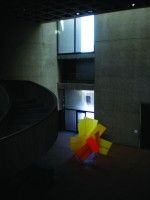Where the Art Is: The Artwork of Jen Pepper

What do the Louvre Museum and Syracuse, New York have in common? (No, it’s not a hidden copy of the Mona Lisa). The Everson Museum of Art, a building designed by the same architect that constructed the glass pyramid in Paris – I.M. Pei. The facade monolithic building, which Pei completed in 1968, incorporates enormous planes of intersecting concrete and a series of ramps that lead up to the main entrance. A spiral staircase, hewn from the same material as the building’s exterior envelope, dominates the spacious atrium. Although it is a small museum, the galleries, which branch off from the entranceway, boast an impressive collection of American art (including a copy of Gilbert Stuart’s portrait of George Washington) and New York state artifacts. What truly makes this museum shine, however, is its celebration of local artists. The Everson famously hosts an exhibition every two years – the Everson Biennial – that exclusively features artists working within the region of Central New York. As an added twist, the Biennial’s 2010 incarnation will be a yearlong series of rotating exhibitions, entitled The Edge of Art.
On Friday, the first exhibit opened with the work of Jen Pepper, a professor of Art at Cazenovia College. Pepper’s show, that which cannot be held, is an extension of her previous work Tautologos, a series of installation sculptures that use synthetic geometric forms and metals to create a world pregnant with movement and language. With her most recent solo show at the Everson, Pepper demonstrates the viability of experimental and abstract art in upstate New York. That which cannot be held is a testament to all things ephemeral – upon entering the room, the visitor’s path is blocked by a diaphanous mesh draping, which is in fact a sheath of finely crocheted galvanized cable. Walking beyond the curtain, one will find several other elements dispersed about the room: a white-coated bed of flowers in the center, a small abstract painting on the right hand wall, another mesh form suspended from the ceiling and a video clip of Chittenango Falls which stretches the entire back wall. Taken collectively, these elements create a sensuous experience that is peaceful, but curious nonetheless. Pepper describes her installation as a “momentary and liminal state, where form and content remain in a pause.”
By weaving together natural and hand-wrought materials, Pepper equates all forms of creation, which each demonstrate a continual process of change, just as the water trickles recurrently in the background or the floating metal mobile seems to dance and transform as one moves around it. By implicating the viewer, the meaning in her work becomes secondary to the experience. Only by entering the room and moving among the objects, can one begin to see that it is not only the artwork itself that activates a process of transformation, but the space between. One must engage in a continual process of understanding and discovery, wherein there is a balance between “getting to know” and “letting go.” In that regard, this piece not only elucidates but also activates the emotive process that Pepper describes as that which cannot be held.






